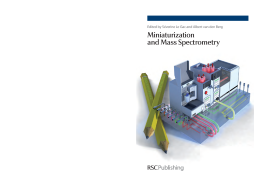
BOOK
Miniaturization and Mass Spectrometry
Daniel Figeys | Gary A Schultz | Daniel Knapp | Steve Arscott | Christian Rolando | Yanou Yang | Jack D Henion | Harold Craighead | Iulia M Lazar | Mihaela Ghitun | Eric Bonneil | Christelle Pomies | Hongfeng Yin | Kevin Killeen | Pierre Thibault | Monica Brivio | Wim Verboom | D N Reinhoudt | Kermit K Murray | Kevin Paul Nichols | Han J G E Gardeniers | Robert J Cotter | Maria Marcantonio | Sara C McGrath | Christine Jelinek | Theresa Evans-Nguyen | Severine le Gac | Albert van den Berg
(2008)
Additional Information
Book Details
Abstract
The recent explosion in the use of analytical chemistry, particularly in the biological sciences, has led to a need for fast, reliable and highly sensitive tools able to handle small sample sizes. This book illustrates how microfluidics and lab-on-a-chip devices can satisfy the growing need for miniaturized and enhanced analysis. They lend themselves well to mass spectrometric detection as they use samples in the low microlitre range and are handled on a chip. Miniaturization and Mass Spectrometry focuses on one particular technique, mass spectrometry, whose popularity has increased dramatically in the last two decades with the increase in use of biological analysis and the development of two "soft" ionization techniques, ESI and MALDI. These enable the analysis of large but fragile biological molecules such as DNA, proteins and oligosaccharides. The book starts with an introduction to the coupling of microfluidics to mass spectrometry techniques. It then goes on demonstrate the advantages of such a coupling: the MS analysis benefits from improved sample preparation when performed on a chip while MS yields more information on the sample handled on the chip compared to conventional optical detection. A history on the developments in this field, starting from the off-chip coupling to the on-chip ionization, is also provided. Daniel Figeys, a pioneer in the development of microfluidic systems for MS analysis, describes the early beginnings of this hyphenated analysis technique. Solutions to couple microfluidic systems to the two most popular ionization methods, ESI and MALDI, are presented throughout the chapters. Various examples are given of the application of this microfluidics-MS hyphenated analysis technique to proteomics, metabolomics, organic chemistry and forensics. Coverage is not limited to academic research. The development of commercialized systems and their current use for routine biological analysis are also presented. Lastly, a future vision of the integration of the mass spectrometer on the chip is raised, as a last step to yield fully portable systems for on-site analysis.
SÚverine Le Gac got her Ph.D. at the University of Sciences and Technologies of Lille (France) in 2004 on the topic of microfluidic systems for mass spectrometry analysis and proteomics applications. Since 2005 she has been working in BIOS, The Lab-on-a-Chip group led by Pr. Van den Berg at the University of Twente. Her current research focuses on microfluidics applications of cell analysis. Since January 2008 she has been appointed as assistant professor in the ame group to lead the research topic "from cell on a chip towards lab-in-a-cell applications. Albert van den Berg leads The Lab-on-a-Chip Group at the University of Twente. His current research interests focus on microanalysis systems and nanosensors, nanofluidics and single cells on chips. He received the Simon Stevin Master award from the Dutch Technical Science foundation (STW) in 2002 and, in the following year, was appointed captain of the Nanofluidics Flagship within the national nanotechnology program, Nanoned.
